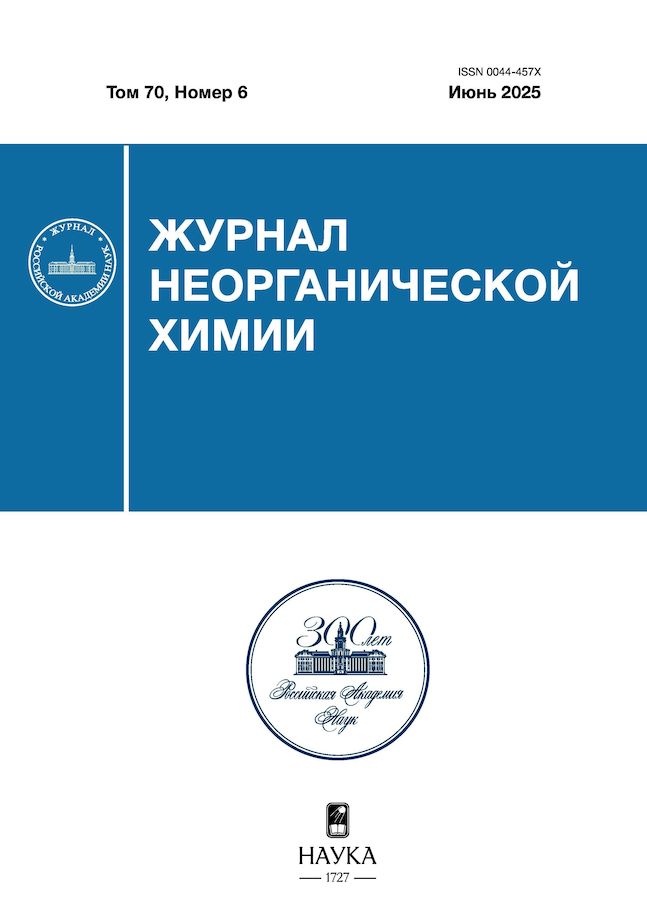Hydride Phases Based on Ta0.33V0.67 Alloy with Partial Replacement of Its Components with Ti and Nb
- 作者: Lushnikov S.A.1, Filippova T.V.1, Mitrokhin S.V.1
-
隶属关系:
- Lomonosov Moscow State University
- 期: 卷 70, 编号 6 (2025)
- 页面: 740-752
- 栏目: СИНТЕЗ И СВОЙСТВА НЕОРГАНИЧЕСКИХ СОЕДИНЕНИЙ
- URL: https://kazanmedjournal.ru/0044-457X/article/view/686351
- DOI: https://doi.org/10.31857/S0044457X25060028
- EDN: https://elibrary.ru/IBBONI
- ID: 686351
如何引用文章
详细
Using of the X-ray diffraction, the reaction products of hydrogen with a volume-centered cubic modification of the alloy Ta0.33V0.67 with partial replacement of its components with titanium and niobium were studied. It was found that the hydrogenation reaction of such alloys results in the formation of hydride samples with varied phase composition and different lattice types. Varying the amount of titanium and niobium in the composition of the Ta0.33V0.67 alloy affects the transition of the crystal lattice from cubic body-centered to face-centered. Hydrogenation of the Ta0.33V0.67 alloy with partial replacement of the components with titanium and niobium leads to the formation of stable hydrides.
全文:
作者简介
S. Lushnikov
Lomonosov Moscow State University
编辑信件的主要联系方式.
Email: Lushnikov@hydride.chem.msu.ru
俄罗斯联邦, 1, Leninskie Gory, Moscow, 119991
T. Filippova
Lomonosov Moscow State University
Email: Lushnikov@hydride.chem.msu.ru
俄罗斯联邦, 1, Leninskie Gory, Moscow, 119991
S. Mitrokhin
Lomonosov Moscow State University
Email: Lushnikov@hydride.chem.msu.ru
俄罗斯联邦, 1, Leninskie Gory, Moscow, 119991
参考
- Sato T., Saitoh H., Utsumi R. et al. // J. Phys. Chem. 2025. V. 169. P. 2865. https://doi.org/10.1021/acs.jpcc.4c06759
- Zhai Y.T., Li Y.M., Wei S.H. et al. // J. Energy Storage. 2025. V. 109. P. 115103. https://doi.org/10.1016/j.est.2024.115103
- Лушников С.А., Мовлаев Э.А., Бобриков И.А. и др. // Неорган. материалы. 2016. Т. 52. № 11. С. 1. http://doi.org/10.7868/S0002337X16110087
- Яртысь В.А. // Коорд. химия. 1992. Т. 18. № 4. С. 401.
- Schippnick P.F., Lawson A.C. // Acta Crystallogr. 1958. V. 11. P. 1643.
- Теслюк М.Ю. Металлические соединения со структурами фаз Лавеса. М.: Наука, 1969. С. 45.
- Lunch J.F., Lindsay R., Moyer R.O. // Solid State Commun. 1982. V. 41. № 1. P. 9.
- Падурец Л.Н., Доброхотова Ж.В. // Журн. неорган. химии. 1997. Т. 42. № 2. С. 184.
- Scripov A.V., Belyaev M.Yu., Stepanov A.P. // J. Alloys Compd. 1993. V. 190. P. 171. https://doi.org/10.1016/0925-8388(93)90395-4
- Shoemaker D.P., Shoemaker C.B. // J. Less-Comm. Met. 1979. V. 668. P. 43.
- Падурец Л.Н., Соколова Е.И., Доброхотова Ж.В. и др. // Журн. неорган. химии. 1995. Т. 40. № 4. С. 669.
- Yakel H.L.Jr. // Acta Crystallogr. 1958. V. 11. P. 46. https://doi.org/10.1007/S0365110X58000098
- Падурец Л.Н., Доброхотова Ж.В. и др. // Журн. неорган. химии. 2000. Т. 45. № 9. С. 1533.
- Figiel H., Przewoznik J., Paul-Boncour V. et al. // J. Alloys. Compd. 1998. V. . P. 29. https://doi.org/10.1016/S0925-8388(98)00566-0
- Scripov A.V., Rychcova S.V., Belyaev M.Yu. et al. // J. Phys.: Condens. Matter. 1990. V. 2. P. 7195. https://doi.org/10.1088/0953-8984/15/21/305
- Scripov A.V., Cook J.S., Karamonik C. et al. // J. Alloys Compd. 1997. V. 253–254. P. 432.
- Fisher P., Fauth F., Scripov A.V. et al. // J. Alloys Compd. 1997. V. 253–254. P. 282.
- Irodova A.V. // Solid State Phys. 1980. V. 2. № 9. P. 2559.
- Somenkov V.A., Irodova A.V. // J. Less-Common Met. 1984. V. 101. P. 481.
- Соменков В.А., Иродова А.В., Шильштейн С.Ш. // Физика металлов и металловедение. 1988. Т. 65. № 1. С. 132.
- Соменков В.А., Шильштейн С.Ш. // Физика металлов и металловедение. 1998. Т. 86. № 3. С. 114.
- Somenkov V.A. // Ber. Bunsen-Ges. Phys. Chem. 1972. V. 76. P. 724. https://doi.org/10.1524/zpch.1979.117.117.125
- Мирон Н.Ф., Щербак В.И., Быков В.Н. и др. // Кристаллография. 1973. Т. 18. С. 845.
- Gibb T.R.P. // J. Phys. Chem. 1964. V. 68. P. 1096.
- Langeberg J.C., McLellan R.B. // Acta Metall. 1973. V. 21. P. 897.
- Hulink J.C. // Delf. Prog. Rep. 1975. V. A1. P. 115.
- Westlake D.G., Mueller M.H., Knott H.W. // J. Appl. Crystallogr. 1973. V. 6. P. 206.
- Muller H., Weymann K., Hartwig P. // J. Less-Comm. Met. 1980. V. 74. P. 17. https://doi.org/10.1016/0022-5088(80)90068-5
- Schober T., Pick M.A., Wenzl H. // J. Phys. Status Solidi. A. 1973. V. 18. P. 175. https://doi.org/10.1002/pssa.2210180114
- Muller H., Weymann K. // J. Less-Comm. Met. 1986. V. 119. P. 115. https://doi.org/10.101016/0022-5088(86)90201-8
- Dewey R.S., Van Tamelen E.E. // J. Am. Chem. Soc. 1961. V. 83. P. 3728.
- Nowak B., Hayashi S., Hayamizu K. // J. Less-Comm. Met. 1986. V. 123. P. 75
- Richter K.H., Weis A. // Ber. Bunsen-Ges. 1988. V. 92. P. 833.
补充文件













